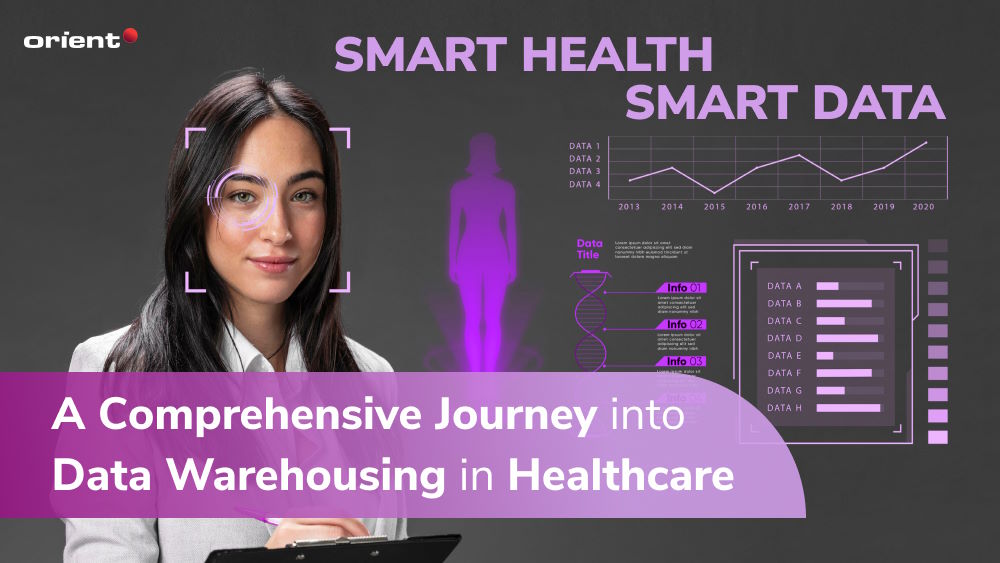Smart Health, Smart Data: A Comprehensive Journey into Data Warehousing in Healthcare

Content Map
More chaptersLet’s start by looking at some interesting statistics about data:
Each day, a staggering 328.77 million terabytes of data are generated globally, encompassing new, captured, copied, or consumed information. This daily influx translates to approximately 0.33 zettabytes, demonstrating the monumental scale of modern data creation.
Inadequate data quality costs companies $12.9 million annually on average.
Despite the massive number of data generated each day, the number highlights that it can be hard to manage poor data quality, and it can be even harder to organize and utilize the existing good data efficiently.
This is where data warehouses come in. A specialized data management system aims to facilitate business intelligence operations, particularly analytics tasks.
Today, we are going to look at the role data warehousing plays in the healthcare industry. With data playing a key role in improving the overall healthcare system, it certainly helps to understand how a healthcare data warehouse works and benefits clinics.
What Is Data Warehousing in Healthcare?
Definition
A data warehouse is a specialized system for managing data used in business analysis and decision-making. It stores large amounts of historical data from different sources like application logs and transactions. By bringing together various data sources, it allows organizations to analyze data deeply, gain valuable insights, and make better decisions. It serves as a reliable reference for data scientists and analysts, offering a comprehensive view of data over time.
Healthcare data warehousing stores healthcare data that comes from various sources - for example, electronic health records (EHRs), ERPs, patient surveys and patient data, CRMs, financial records, health tracking apps, etc.
Despite storing such a large amount of data, a data warehouse is only one component among the large data management platforms that are made up of multiple layers that eventually use data analytics to transform raw data into usable data.
Healthcare Data Management
The nature of healthcare requires the storing, organization, and management of data to be accurate, reliable, and accessible to those who need it. Moreover, the management of such data requires one to strictly comply with guidelines and regulations like the USA’s HIPAA and Europe’s GDPR.
The Architecture of a Data Warehouse

Data warehouse architecture refers to how a system is set up and organized. It is a centralized repository for structured and semi-structured data sourced from diverse origins.
There are two common types of data warehouse architecture: Individual data warehouse and enterprise data warehouse.
Individual Data Warehouse
More focused on an individual area or function in the healthcare organization, an individual data warehouse (sometimes referred to as an individual data mart) is a more “condensed” version of the data warehouse dedicated to a specific department or unit. Due to its smaller scale, it also receives data from fewer sources compared to its enterprise counterpart. This type of data warehouse is suitable for small to mid-sized healthcare organizations.
Even though this data model provides a more focused view of data that helps the team implement and measure metrics faster, it can cause data redundancy in the long run.
Enterprise Data Warehouse
Another type of data warehouse in healthcare is the enterprise data warehouse. While the individual model takes a bottom-up approach, the enterprise data warehouse takes the top-down approach. This model is more suitable for large health organizations due to the sheer amount of data and its multiple layers of data analytics. The enterprise model is made up of four main layers.
Data Source Layer
As the name suggests, this layer includes internal and external data from multiple sources like EHR, ERP, pharmacy management systems, claim management systems, etc.
Staging Area
The second layer of healthcare data warehouses is data storage. It acts as an intermediate temporary storage for the data stream from the first layer. Here, two methods are used to pick out high-quality data without duplicates, inconsistencies, or inaccuracies. The first method is called ETL, which is short for extract, transform, and load, where data is loaded in its raw form and then modified on demand. The second method is ETL or extract, transform, and load, where data is formatted first and then loaded into the warehouse.
Data Storage Layer
This layer serves as the centralized and unified repository for data storage. Data is loaded into this repository through ETL/ELT methods and is awaiting analysis and reporting. Additionally, it may contain individual data marts, which are subsets of data tailored for specific business functions such as accounting or HR, as well as for different departments like radiology and pediatrics.
Analytics and BI (Business Intelligence)
The 4th layer is where healthcare providers can implement analytical toolkits like business analytics, data mining, statistical analytics, and data visualization or use third-party apps for the same purposes. Additionally, AI (artificial intelligence) and machine learning (ML) are also great tools for making informed decisions.
Data Warehouse for Healthcare: Valuable Integrations
There are four valuable integrations organizations should consider maximizing the use of a data warehouse
Data Lake
Before the warehouse questions the semi-structured data, the data lake is a cost-effective location for this type of data. Moreover, the data stored can be used to train ML models.
ML Software
ML is a great tool for predictive analytics. With the structured, stored data from the clinical data warehouse, ML software produces insights that support diagnoses and personalized healthcare.
Self-service BI Software
BI software is another great integration that supports decision-making. Still using organized and modified data, with techniques of descriptive analytics and data visualization, it automates reporting and creates dynamic dashboards.
Key Features You Need to Pay Attention To
Data Integration
Data integration is a key aspect of a healthcare data warehouse. Unstructured, semi-structured, or structured data that comes from HR management systems, EHR systems, and ERP systems are involved in data integration.
Along with methods like ETL/ ELT that create a controlled data loading/ management, this process also involves:
- Complex data transformation tasks, like data type conversion and summarization for standardized data for analysis.
- Big data and streaming data ingestion are used to enable medical data loading and querying.
Database Performance
A data warehouse with strong performance is one with rapid data retrieval and seamless query execution abilities.
- Automated data backups for emergency cases.
- Scalability for optimal resource usage.
- Machine learning capabilities
- Healthcare data indexing materialized view support and result caching for high-performing query processes.
When it comes to handling healthcare data in medical devices, features like parallel task execution for breaking down complex queries help boost overall performance.
Security and Compliance
Healthcare data security should always be one of your top priorities and never an afterthought. Several features help you safeguard the information and comply with regulations like the Protected Health Information (PHI) or GDPR.
- Strict access control to sensitive data. This can be done by granularly implementing IAM (Identity and Access Management)
- Using multi-factor authentication
- Restrict or limit access to particular jobs.
- Encrypt data on healthcare during usage and rest
- Adhere to medical laws and regulations.
- Automated backup in cases of data loss emergencies
Scalability
A data warehouse in healthcare should be able to grow alongside the organization. Similarly, it should also be able to scale down when needed. This ability refers to both the warehouse’s storage and computation power.
History Tracking
By tracking changes in data, data warehousing creates an audit trail that enables healthcare professionals to access patient history and other important metrics. This helps identify changes in conditions and improve the quality of healthcare services provided.
Key Steps for Healthcare Data Warehouse Implementation
A data warehouse is quite technical. Thus, the implementation without professional help can be quite tricky. However, there are basic steps that one needs to go through.
Feasibility Study
First, you need to examine whether the project’s viability aligns with the business needs and objectives.
Planning Phase
Then, it is time to analyze the requirements and select the platforms.
- What are the stakeholders’ requirements?
- What are the high-level requirements for the warehouse?
- What are the key strategies involving risk management, budgeting, or security requirements? How do such strategies align with the stakeholders’ needs?
- What are the project timeframes, milestones, and deliverables?
- What are the data warehouse conceptualization and platform selections, considering the number of data flows, security requirements, etc.?
Data Warehouse Architecture Design
After the planning project, it is time to lay out what format you want to use while deciding the framework for the data warehouse. Consider all the crucial features and valuable integrations we mentioned earlier, along with the following:
- The preferred data model
- Validation processes
- Data integration data strategy
Development of the Medical Data Warehouse
Coding is often the most time-consuming phase. It involves working on the infrastructure as well as the software and end-user apps. Data governance policies are also involved in this stage.
Launching
Once the data warehouse is built and tested to ensure it meets reliability, performance, and scalability requirements, it is time to deploy the system. The system can be deployed on-premise or on the cloud, where the relevant data is then migrated to the new environment.
Support and Improving
Every technology needs constant maintenance and improvement. This means the development team needs to continuously perform evaluation and evolution of the data warehouse to meet business needs, technological advancements, and regulatory requirements.
Benefits of Healthcare Data Warehouse
Informed Decision Making
A massive volume of data doesn’t mean better decision-making. With a healthcare data warehouse, healthcare providers have a unified source of structured data. Moreover, the data is analyzed through a variety of analytic techniques, allowing professionals to make data-driven decisions instead of doing pure guesswork.
Better Patient Retention
By leveraging comprehensive data insights and adopting a patient-centric approach, healthcare organizations elevate the overall patient experience, improving patient retention rates. Warehouses also give patients the choice to actively participate in their treatment by giving them access to medical data.
Data Security
Ensuring the security of medical data is of utmost importance for every healthcare organization. Data warehouses can help establish role-based access controls, which means that only authorized staff can access sensitive information. In addition, other security measures can be implemented, such as limiting access to data through reports or implementing encryption protocols to prevent unauthorized access.
Streamlines Claims and Payments
It is no secret that processing insurance claims has long been one of the biggest headaches for hospitals. Not only is it time-consuming to retrieve data, but healthcare professionals also need to keep an eye out for fraudulent payouts. With the assistance of data warehousing, this process is streamlined, making the clinic’s and patient’s lives much easier.
Improves Data Integrity
Data warehousing tools improve data quality through the multiple layers that turn raw data into a standardized format and remove inconsistencies and errors while also establishing metrics for data quality. All of this is done before the data reaches its target location.
Challenges and How a Partner Can Help You Navigate Them
Navigating the world of technology might be tricky, and healthcare data warehouses are no exception. From data integration complexities to system compatibility issues, challenges abound. No need to worry, as outsourcing partners are here to save the day. With ready-to-go resources and expert teams, they’re equipped to tackle your problems head-on. Whether you’re facing unique hurdles or seeking to enhance existing features, outsourcing is the solution.
At Orient Software, we’re committed to exceeding expectations and delivering top-notch results. Still on the fence? No problem. Get a business quote within three days, and let us help you make the right choice.







